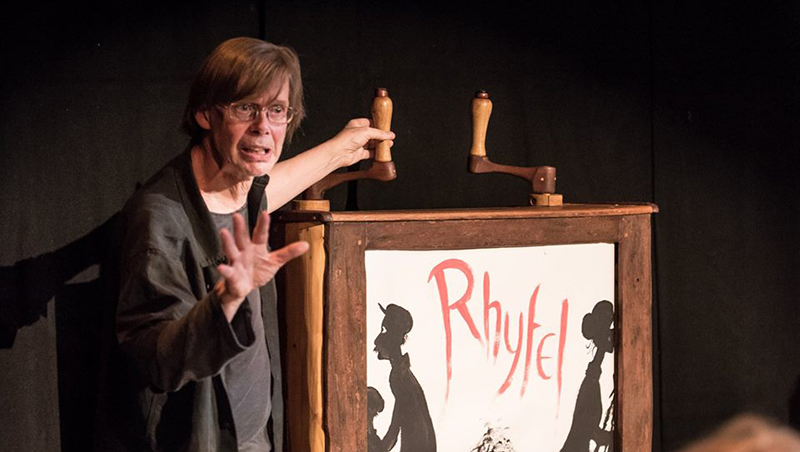
Peter Stevenson – October 2021
Peter Stevenson shares with us his latest updates on his projects – Wales Appalachia Project, Chwedl Dŵr, Uisce Dŵr Water, Ports Past & Present, Boggarts Trolls & Tylwyth Teg, and the Wales India Project.
What is the project?
In 2016, I began working on a series of complementary projects exploring ideas of borders and migration through folk tales and storytelling, all inspired by the British government trying to draw a boundary in the Irish Sea to distinguish themselves from Europe, and the then US president’s mandate to build a wall to keep Mexicans out.
The Wales Appalachia Project began in 2019 when I curated an exhibition of Welsh and Appalachian folk art in Morgantown, an old Welsh settlement city in West Virginia, where the local storytelling guild helped create a storytelling festival. The exhibition was then shown at Aberystwyth Storytelling Festival, and the project will continue in Spring 2022 in the old Welsh coal baron’s town of Welch, West Virginia (yes, Welch really exists, and so does a nearby coal town, Jenkinjones). The project has also borne a book, ‘The Moon- eyed People’, and a storytelling show which was performed in the Casglu tent at BtB 2021 with the amazing Ailsa Mair Hughes.
https://www.wvpublic.org/news/2019-05-22/art-exhibit-explores-appalachias-connection-to-wales
https://www.wvpublic.org/news/2020-05-29/folktales-and-music-bring-to-life-the-w-va-welsh-connection
Chwedl Dŵr, Fairytale of Water: a film commissioned by WOW (Wales One World Film Festival) for their Ecosinema project in September 2021, based on the short films about Welsh folk tales I’ve made with Jacob Whittaker. This offered us the opportunity to explore ideas of water as a fluid border, and introduce oral storytelling to a much wider audience.
https://www.wowfilmfestival.com/
Ports Past and Present is the same project that Gill Brownson has written about in an
earlier Ysbrydoli. I’m working in Abergwaun, where I’m writing a book and making a film with Jacob about the folk tales and culture of the sea crossing to Rosslare, for which I’ve interviewed storytellers Deb Winter, Christine Willison, and Hedydd Hughes from Straeon Gwaun. The project is funded by Cork, Dublin and Aberystwyth Universities and the EU.
https://portspastpresent.eu/peterstevenson-jacobwhittaker
Boggarts Trolls and Tylwyth Teg, Folk Tales of Hidden People and Lost Lands, is a book which germinated in New Zealand at the end of 2019, and was written in Wales during the isolation of 2020 when travel wasn’t allowed. Yet it is a travelogue, a folk history of migration, beginning and ending in Ceredigion, crossing many borders along the way. https://www.thehistorypress.co.uk/publication/boggarts-trolls-and-tylwyth-teg/9780750995627/
Wales India Project: A series of workshops designed to help young people express their
concerns about their environment using the techniques of oral storytelling, illustration, film making, writing and animation. The workshops are run in collaboration with illustrator Ekta Bharti and animator Anwaar Alam in India, and animator Charlie Carter in Wales. Sessions are currently taking place at Aberystwyth Arts Centre and the project is funded through the British Council, ACW and Dream a Dream. https://www.aberystwythartscentre.co.uk/weekly-courses/india-wales-project-ages-12
Who is it for and how can people get involved?
The next stage of the Wales Appalachia project is for schoolchildren in Welch WV.
The film Chwedl Dŵr has been shown at WOW and will be available at other festivals and online, and hopefully will be of help to those involved in filming story walks for BtB.
The Ports project will reach a conclusion in spring 2022 with storytelling and public events in Wales and Ireland, along with the publication of the book Uisce Dŵr Water.
Boggarts Trolls and Tylwyth Teg will be published in October and available to all.
The Wales India sessions can be booked through Aberystwyth Arts Centre and some workshops will be online, and hopefully will connect with young storytellers across Wales.
Tell us a more about yourself in a short biog. How did you start storytelling. How long have you been doing this. Where are you based, How do you work with story?
I’m based in Aberystwyth and have told stories since I was a child when I used to make them into handmade picture books, something I still do, only now they’re called artist books. Storytelling really took off as a way of life when I went to Manchester Art College to study illustration and fairy tales, and then to the Institute for Dialect and Folklife Studies at Leeds University where I began gathering stories old and new. I’ve spent my life illustrating books of fairy stories, including some for Ladybird Books, and then the pictures leapt off the pages and became kamishibai, crankies, magic lanterns, slideshows, and puppets. And so I became a visual storyteller.
You ask how I work with story. Well, it takes a long time. I can’t tell a tale from a text only. I visit the landscape of the story, talk with local people, work in archives, imagine and draw the characters, until I can see the story clearly in my head. Only when the story becomes more than a text, only then can I tell it.